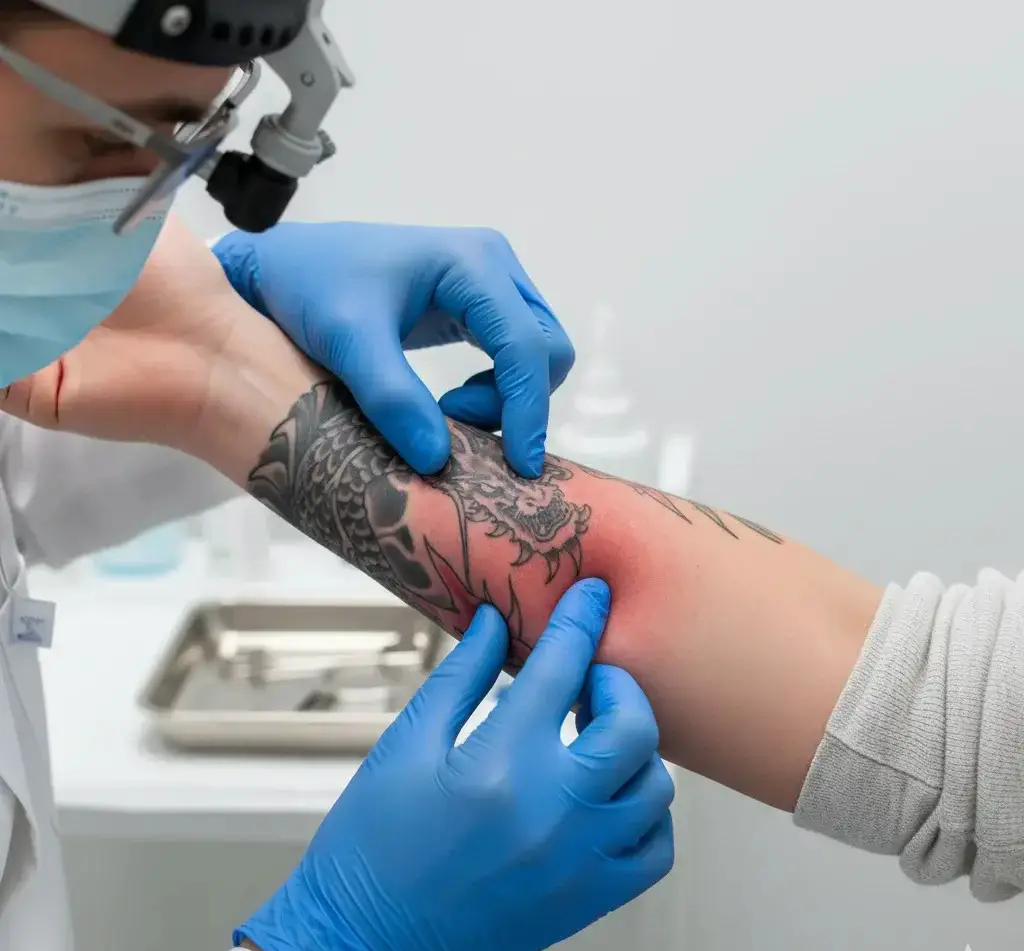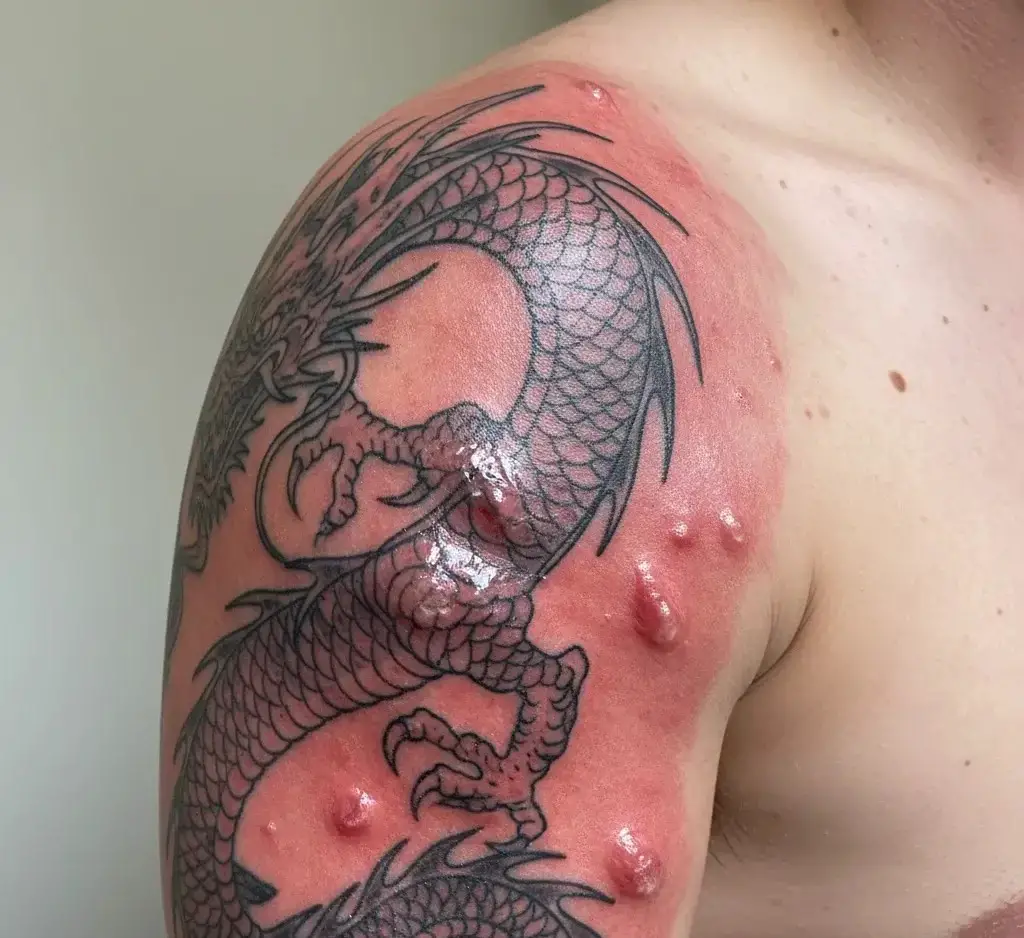Have you ever looked at your fresh tattoo and suddenly noticed redness, swelling, or warmth spreading around it?
That scary moment can make anyone panic and wonder, will cellulitis ruin my tattoo?
Cellulitis is a bacterial infection that can sneak into your skin while your tattoo is still healing, turning what should be an exciting experience into a painful one.
If left untreated, cellulitis can cause serious skin damage and even affect how your tattoo looks.
But the good news is — with quick action and the right care, you can protect both your health and your ink.
Understanding how cellulitis starts, what warning signs to watch for, and how to treat it can make all the difference in saving your tattoo from lasting harm.
What Is Cellulitis And How Does It Affect Tattoos?
Cellulitis is a serious bacterial skin infection that can happen when bacteria enter through broken skin — like a fresh tattoo.
It causes redness, swelling, warmth, and pain in the affected area. Since tattoos are open wounds during healing, they’re vulnerable to infection.
If not treated early, cellulitis can damage the tattoo’s color and cause scarring or texture changes on the skin.
Can You Get Cellulitis From A New Tattoo?
Yes, cellulitis can develop from a new tattoo if hygiene isn’t maintained during or after the tattooing process.
Dirty needles, unsterilized equipment, or touching the tattoo with unclean hands can introduce bacteria.
Even minor mistakes in aftercare — like scratching or soaking the tattoo too early — can increase the risk of infection leading to cellulitis.
Will Cellulitis Ruin My Tattoo Permanently?
If caught and treated early, cellulitis usually won’t permanently ruin your tattoo. However, if the infection spreads or becomes severe, it can distort the ink, cause fading, or leave scars.
The severity of damage depends on how quickly you get medical help and how deep the infection goes into the skin.

Early Signs Of Cellulitis After Getting A Tattoo
Watch for these signs within a few days of getting tattooed:
- Increasing redness and warmth around the tattoo
- Pain or tenderness that worsens instead of improving
- Swelling and hard patches under the skin
- Pus, blisters, or yellowish drainage
- Fever or fatigue
If you notice these symptoms, contact a doctor immediately.
How To Tell The Difference Between Tattoo Infection And Cellulitis?
A regular tattoo infection usually stays localized to the tattoo area, showing mild redness and irritation.
Cellulitis, on the other hand, spreads quickly beyond the tattoo and causes intense swelling, pain, and fever.
If the redness keeps expanding or the area feels hot and firm, it’s more likely cellulitis rather than a mild infection.
What Causes Cellulitis On A Fresh Tattoo?
Cellulitis often develops when bacteria such as Staphylococcus or Streptococcus enter through open tattooed skin. Common causes include:
- Unsanitary tattoo tools or surfaces
- Improper aftercare or touching the tattoo with dirty hands
- Scratching scabs or picking flakes too soon
- Exposure to contaminated water (like pools or hot tubs)
Maintaining a clean healing environment helps prevent these issues.
Can Cellulitis Change The Color Or Shape Of A Tattoo?
Yes, cellulitis can alter your tattoo’s appearance. Severe swelling or blistering can distort the lines, while inflammation might cause the ink to fade or look patchy.
Once the infection heals, the affected skin may appear uneven or scarred, which can make the tattoo’s color and shape look different from the original design.
How Fast Does Cellulitis Spread On Tattooed Skin?
Cellulitis can spread quickly — sometimes within 24 to 48 hours. The redness and pain may start small but can rapidly expand to surrounding skin.
The faster it spreads, the higher the risk of complications. That’s why early medical treatment with antibiotics is crucial to prevent permanent skin or tattoo damage.
What To Do If You Suspect Cellulitis On Your Tattoo
If you suspect cellulitis, don’t wait it out. Take these steps immediately:
- See a doctor or go to urgent care for antibiotics
- Keep the tattoo clean and dry
- Avoid applying creams or ointments unless prescribed
- Stay hydrated and rest to support healing
Delaying treatment can worsen the infection and increase the chance of scarring or ink damage.
When Should You See A Doctor For Tattoo Cellulitis?
See a doctor as soon as you notice spreading redness, swelling, or severe pain. If you develop a fever or red streaks moving away from the tattoo, seek emergency care.
Cellulitis can spread into deeper tissues or the bloodstream, so professional treatment is necessary — home remedies are not enough in this case.

Can You Still Save Your Tattoo After Cellulitis?
Yes, many tattoos recover well after cellulitis once the infection is properly treated. Mild fading or uneven color can sometimes be touched up by your tattoo artist later.
The key is to allow full skin recovery before any retouching — usually several months — and to follow all aftercare guidelines strictly to avoid another infection.
How Long Does It Take For Cellulitis To Heal On A Tattoo?
Healing time depends on the infection’s severity. Mild cases may improve within 7–10 days with antibiotics, while deeper infections can take a few weeks.
After the skin heals, your tattoo may look dull or uneven for a while, but you’ll notice gradual improvement as the tissue regenerates.
Can Antibiotics Fix Cellulitis Without Damaging The Tattoo?
Yes. Antibiotics target the bacteria causing cellulitis without affecting the tattoo ink itself. However, the infection’s inflammation may still cause slight fading or distortion.
Once antibiotics start working, swelling and redness should reduce within a few days, minimizing long-term effects on your tattoo.
Tattoo Aftercare Tips To Prevent Cellulitis
To lower the risk of cellulitis after getting a tattoo:
- Always choose a licensed, clean tattoo studio
- Wash your hands before touching the tattoo
- Clean the area gently with fragrance-free soap
- Avoid soaking or swimming until fully healed
- Follow your artist’s aftercare instructions carefully
Good hygiene is the best defense against skin infections.
How To Reduce Scarring Or Color Loss After Tattoo Cellulitis?
Once healed, use fragrance-free moisturizers to restore skin elasticity. If scarring or fading appears, a professional tattoo artist can do minor touch-ups.
Protect the area from sun exposure since UV rays worsen discoloration. Patience is key — let your skin recover completely before considering any cosmetic fixes.
Can You Get A New Tattoo After Having Cellulitis?
Yes, but only after your skin fully heals and your doctor approves. Getting a new tattoo too soon increases infection risk.
Wait several months to ensure the area’s skin barrier is strong again. Always choose a trusted tattoo artist and follow strict aftercare to prevent recurrence.
Will Cellulitis Come Back On The Same Tattooed Area?
It’s uncommon but possible. If bacteria enter the same weakened spot again, cellulitis could return.
Keeping your immune system strong and maintaining good hygiene lowers the risk.
If you’ve had cellulitis before, inform your tattoo artist and take extra care during aftercare.
My Tattoo Looks Blotchy After Cellulitis — Is It Normal?
Yes, blotchiness can happen as your skin regenerates. The infection and healing process can cause uneven pigment distribution.
Over time, the color may even out slightly. If not, once the skin is fully recovered, a professional artist can fix any faded or patchy areas with careful touch-up work.
How To Care For Healed Skin After Tattoo Cellulitis
After recovery, keep the area moisturized and protected. Avoid harsh soaps or exfoliants for several weeks.
Applying sunscreen daily helps preserve tattoo color and prevent new irritation. If you feel tightness or dryness, use a healing balm recommended for tattooed skin.
Final Thoughts: Protecting Your Tattoo From Cellulitis Damage
Cellulitis doesn’t have to ruin your tattoo if you act fast and care properly. Clean environments, good hygiene, and prompt medical attention are the real protectors of your ink.
With patience and care, your tattoo can still heal beautifully and stay vibrant for years.
Read More Blogs:
- 16 Sweet & Meaningful Sister Tattoos For 3 That Show Unbreakable Love
- 15 Bold Men Eagle Tattoo Ideas That Scream Power & Freedom
- What To Use Instead Of Vaseline When Tattooing: Safe Alternatives That Work
- 15 Stunning Walk By Faith Foot Tattoo Designs With Deep Meaning
- 15 Stunning Purple Tattoo Ideas You’ll Wish You Tried Sooner
- Can I Take A Muscle Relaxer Before Getting A Tattoo? Risks, Safety & Better Options
- Can I Put Saniderm On A Week Old Tattoo? Expert Aftercare Guide
- What Can I Use Instead Of Green Soap For Tattooing? 12 Safe Alternatives
- Tattoo Aftercare For Sensitive Skin: Safe Healing Tips
- When Can You Safely Shave Over A Tattoo? Full Guide
- Can I Use Shea Butter On My Fresh Tattoo? Read This First
- Can You Die From Tattoo Infection? Signs You Must Know
- Tattoo Flu: Symptoms And Prevention Guide
- Can You Get A Tattoo If You Have Sensitive Skin? A Full Guide
- Can A Spine Tattoo Paralyze You? The Real Truth Inside
- 14 Hawk Tattoo Ideas With Deep And Powerful Meaning
- 12 Creative And Fun Opossum Tattoo Ideas To Try
- 13 Elbow Tattoos For Women That Look Stunning & Bold
- 12 Beautiful Daughter Tattoo Ideas That Show Endless Love
- How Do You Make Homemade Tattoo Ink With A Pencil?
- 15 Raccoon Tattoo Designs That Are Cute And Creative
- 15 Stunning Bat Tattoo Ideas You’ll Want To Try Right Now
- 13 Hairstylist Tattoos That Show Your Love For The Craft
- 13 Stunning Jasmine Tattoo Ideas With Deep Meanings To Try
- 13 Stunning Pothos Tattoo Designs For Plant Lovers
- 12 Best Rengoku Tattoo Designs Every Demon Slayer Fan Will Love
- 12 Autumn Tattoo Designs That Capture Cozy Fall Vibes
- 15 Red Cardinal Tattoo Ideas That Look Stunning On Skin
